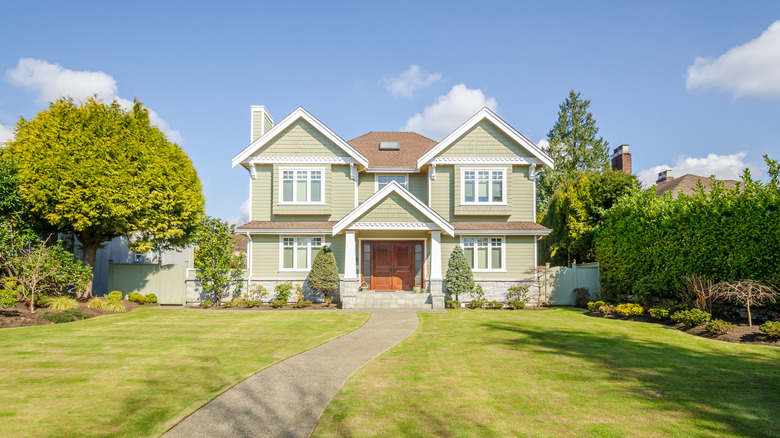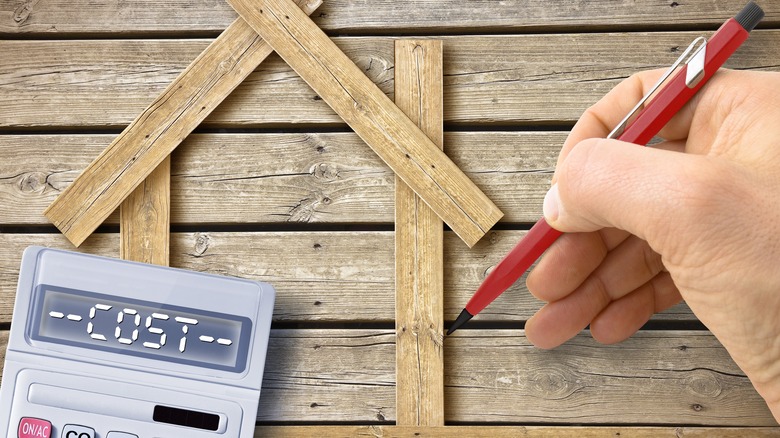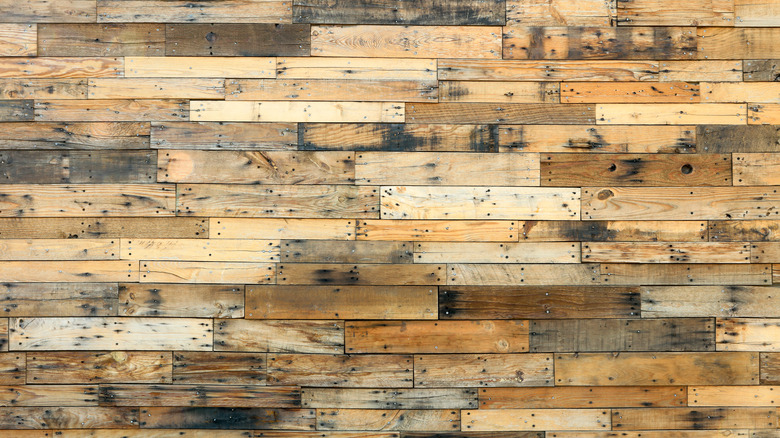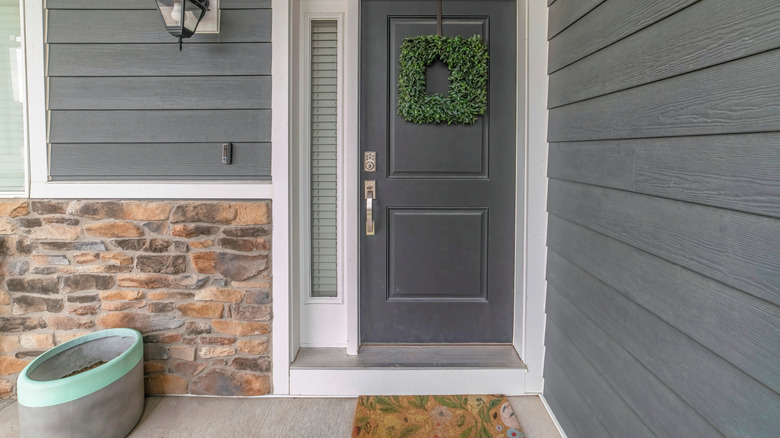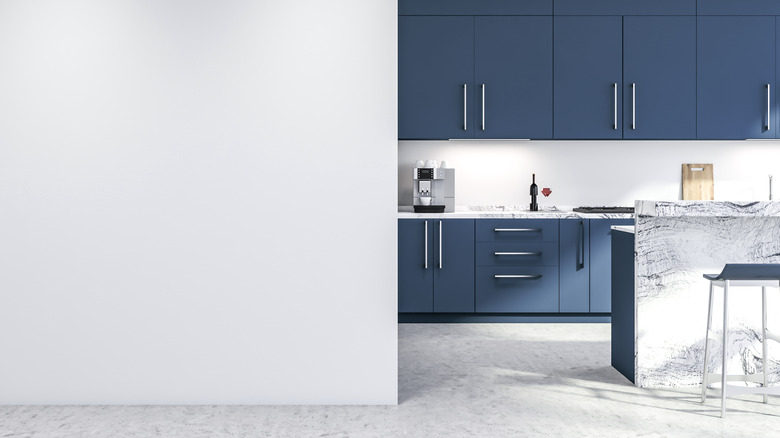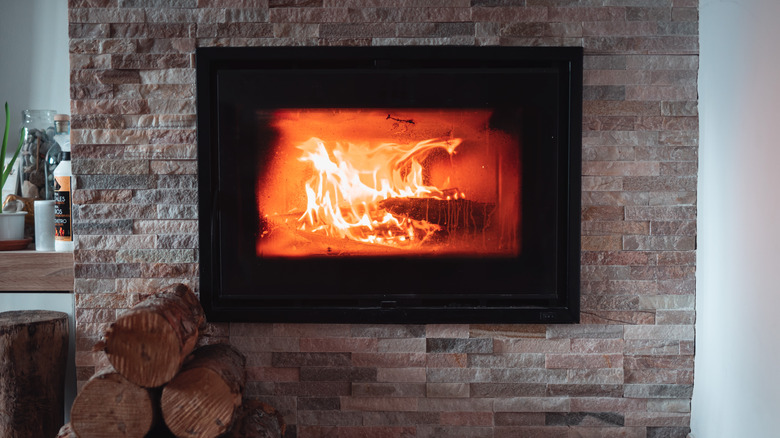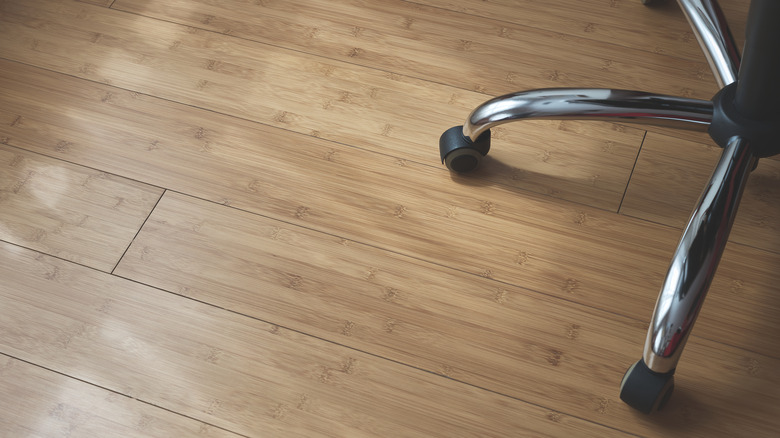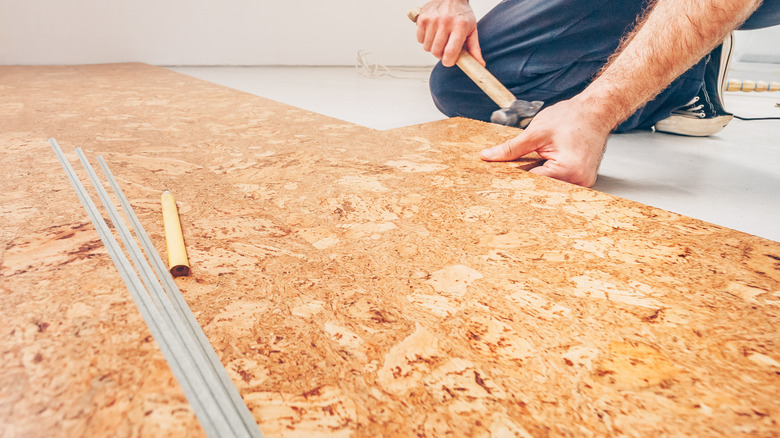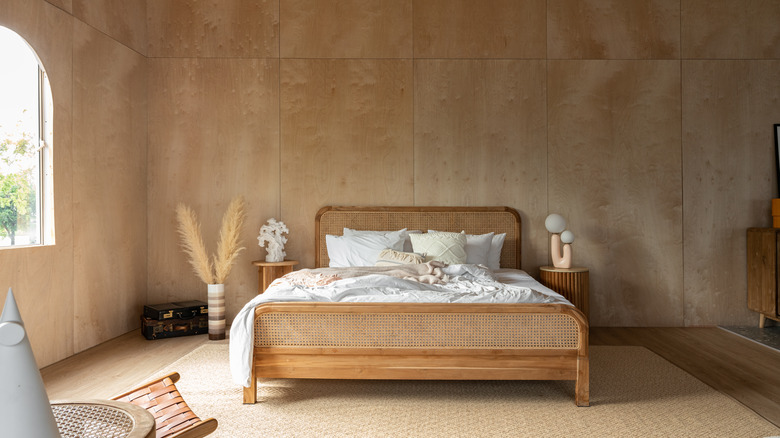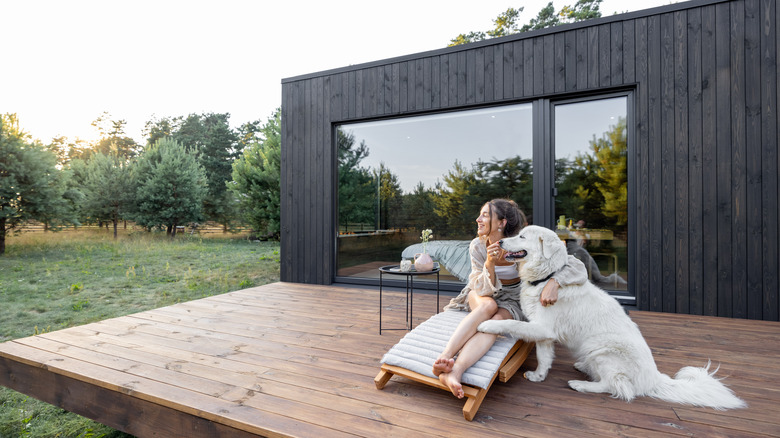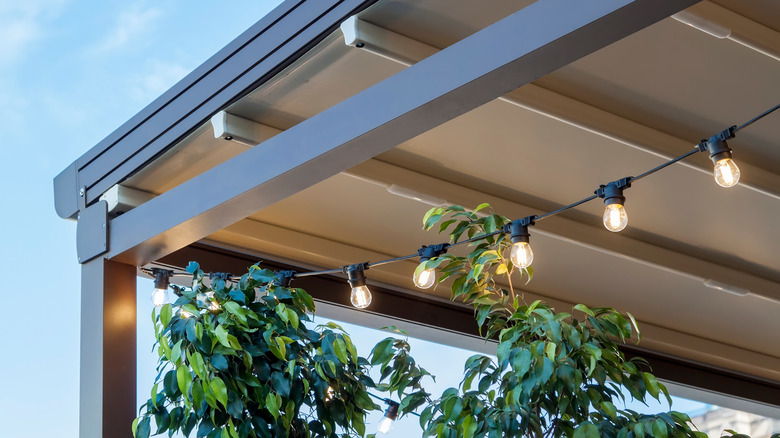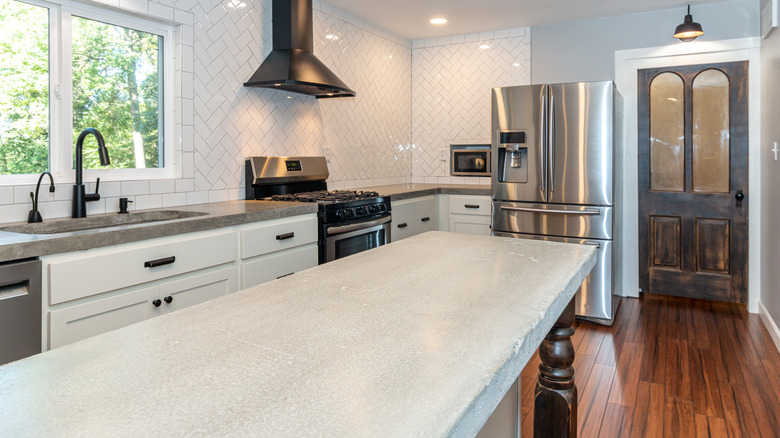Inexpensive Supplies For Your Next Home Building Project
Building a house is no small undertaking, but it's well worth it. According to American Family Insurance, building from scratch has several benefits, such as giving the homeowner the ability to customize exactly to their needs, have a truly move-in-ready home, and design it in a way that is modern and trendy with the latest technology. To make all that happen, the right materials must be considered.
What comes to mind when you think about building materials? For many people, it's the usual items, such as wood for framing, granite for counters, and vinyl siding. Those are all important, and you can incorporate them into your new build if they suit your style and budget. Still, you may want to investigate some other supplies that are a bit more unique and could save you a lot of money. Even traditional homes benefit from building materials that are out of the ordinary. In this article, we'll look at inexpensive supplies for your next home building project that you may not have considered before, or at least not for some of the purposes they can fulfill. Try something new and make a statement or save on building costs while getting the results of an expensive-looking house.
Average cost to build a home
The cost to build a home varies, depending on square footage and what area of the country you live in. Building a house in rural Kentucky will be cheaper than building a home in Los Angeles. According to Quicken Loans, the national average cost to create a new home in the U.S. is $284,000, with the lowest average at $80,000 and the highest at $1 million. That's quite a range and a good chunk of change no matter what end of the spectrum you're at. Trying to save where you can is a wise idea.
Building a new home is seldom a last-minute, quick decision. It's best to look at all your options and plan ahead. If building from scratch is your dream and you don't want a preexisting home, look for ways you can save some money. Is there some work you can do yourself? Maybe you can negotiate with electricians and plumbers if you have some skills you can use to help them out. Look for building supplies that are less expensive than traditional materials. Be patient and stick with your plan; eventually, you'll have the home you envisioned.
Stick with your budget
Don't start a building project without a budget. It's important to leave a little wiggle room, but you also want to do your best to stick to the original plan. Some people are uncomfortable with the word budget. It makes them think of strict rules and no flexibility. However, a budget is just the opposite. It puts things into place and gives you a feeling of freedom, knowing there's a plan and the money is available. According to Investopedia, budgets help us keep our eye on the prize by encouraging us to map out our goals, see the progress, and turn our dreams (in this case, a dream home) into a reality.
A budget is simply a tool that works for you, not against you. To create one for your home building project, track every penny your household spends over a month or more. Subtract that amount from your monthly income, and you'll see what you have to work with. You'll also notice areas you may be willing to stop spending so you can spend more on the new home. Remember, if the budget is tight, look for ways to cut back and still get the home you want.
Reclaimed wood
Reclaimed wood looks great and is better for the environment. Every time we reuse wood, we are slowing the need to chop down another tree. According to the United States Environmental Protection Agency, when we repurpose items, we are helping to prevent pollution, reduce greenhouse gases, save money, cut down on energy use, and improve and sustain the environment for future generations. It may seem like a little thing when you choose reclaimed wood as part of your building project. However, the reality is that we'd significantly impact the environment if everyone did it. Let that encourage you to do your part.
Besides being eco-friendly, reclaimed wood offers a rustic charm that brand-new timber can't compete with. Use it for fireplace mantels, shelves, flooring, kitchen counters, and even kitchen cabinets. You can find reclaimed wood at salvage shops and through businesses that specialize in rescuing beautiful, useable lumber from old buildings.
Shipping containers
Another eco-friendly and budget-friendly material to use for building a home is metal shipping containers. They're strong, solid, and easy to move around. Sometimes it can be hard to wrap our brains around such unusual, new ideas. That's because we've seen things done the same way for generations. The idea of using an item like a shipping container may sound ridiculous until you hear why it's not.
According to Brekke Storage, people are becoming increasingly interested in the storage container option for home building because they're repurposed items, making them eco-friendly, affordable, and almost always cheaper than other building materials. They're sturdy, and they're recyclable. UpNest estimates the average cost to build a shipping container home is $10,000 to $35,000. For large shipping container homes, it can be near $175,000. That's still much cheaper than building a large house from traditional materials. When pieced together, the containers create a modern-style home and work especially well for those desiring a minimalist lifestyle.
Stone cladding
Stone cladding or veneer is a thin layer of stone, usually made from molded concrete, placed on top of an existing wall. It can even be placed right over most other materials, such as wallpaper, paint, metal, wood, or drywall. The thin layer isn't as heavy as natural stone — in fact, it's as much as 80% lighter. It's also less expensive. Stone cladding is used on both exterior and interior walls for a rustic look and added texture. The cladding comes in panel sheets, making it easy to install, and it's often weatherproofed, flexible, and easy to maintain.
It's basically like installing wood paneling, except you're left with a unique stone wall. Go ahead and get creative with stone cladding. You'll find it in a multitude of styles, from chunky rocks fit for a cabin to smooth stone used in contemporary homes. Try stone cladding around a fireplace, on a living room wall, as a backsplash, or on a home's exterior for added interest.
Concrete slabs and raw concrete
Using concrete in any form saves costs. It's a flexible material, offering both a rustic vibe and a modern, industrial look. It's becoming increasingly popular and is even used as the main material for an entire concrete house. According to Archute, concrete homes are growing in popularity due to their weather resistance capabilities and their low energy use, thanks to concrete's natural ability to insulate. A concrete home can be cast on site using removable forms or with a more recent way of building with concrete, using ICFs (insulated concrete forms). These forms stay in place, supported by steel after the concrete is poured, leaving even greater insulation. Another way of building with concrete is to have concrete slabs brought in.
If you aren't interested in building a concrete house, you can still reap many benefits from this strong material. Concrete counters look edgy and modern in the kitchen or bathroom, as do concrete poured sinks. Use concrete as highly durable flooring or as a hearth, mantle, or face of the fireplace. Concrete can even be colored, making the possibilities endless.
New brick and salvaged brick
Brick is sometimes an expensive material, but there are ways to save money using it. For starters, search for used bricks to cut back on the cost. Bricks are worth the time and money because they last. With that in mind, it makes sense to repurpose old bricks. Many homebuilders love the look of brick because it connects them to the past. Brick was used for everything many years ago, including homes and streets. Most of those homes and roads are still standing today.
You can find old bricks to repurpose through local ads and online marketplaces. Since an entire house of bricks may be too expensive, look for other ways to incorporate some durable bricks into the home. According to ET Clay, some homeowners use bricks to achieve a cottage feel in their homes, laying down brick patterned floors and cupboards. You can create something similar by designing an accent wall in your living area, building a walking path, or creating an elegant driveway.
Eco-friendly bamboo
Bamboo can be used in the home for flooring, walls, and anywhere you may use wood. It's also eco-friendly due to the fact that it renews quicker than traditional timber. Did you know bamboo is technically a grass? It is, indeed, but certainly grows like a tree. According to The Constructor, bamboo grows three times faster than other plants in the world. That means when one bamboo plant is cut down for use, another planted to replace it will grow quickly, renewing the bamboo forest. According to One Tree Planted, the fastest-growing bamboo can grow up to almost 3 feet in one day. That's an impressive, renewable source. Other trees, often used as building materials, will take much longer to grow and renew.
Bamboo is known for its lightweight yet great strength. Homeowners like that it's reasonably priced, durable, and allows them to have an eco-friendly home. In the U.S., bamboo is most popular as a flooring material. It looks like any wood floor but is scratch and moisture resistant. Although bamboo has been used as a common building material in some areas for centuries, we are only now beginning to see greater use of it as a building material in the Western hemisphere.
Versatile cork
According to Build Direct, cork comes from the cork oak tree, found in southern Europe and northern Africa. The cork we use in our homes comes only from the bark, which is stripped from the tree and eventually grows back. The cork oak tree is never cut down or damaged during harvest. In homes, it's used for flooring, underlayment, insulation, wall coverings, and even countertops. One reason builders and homeowners love cork is that it naturally has air pockets, which allow for a little give when stepped on. As flooring, it's easy on the feet. As insulation, those air pockets assist in holding the air in one place so it can't escape, helping to maintain the temperature in the house.
With cork's natural, anti-microbial properties, it's an excellent choice in the kitchen and bathroom. It also resists mildew and moisture. There isn't much to dislike about cork. While it's comparable in price to other supplies like wood, it's recyclable, unlike some other materials, and considered one of the most sustainable building materials you can choose. That's a bonus for our environment.
The many uses of plywood
Plywood doesn't get enough respect. It's sometimes looked down upon because it's inexpensive and not a pure piece of wood. According to F.A. Mitchell, it's a wood composite material, which means it has several sheets of veneers pressed together. The veneers are manufactured from real wood. Plywood is very useful and a huge cost savings. As a home builder or homeowner, you may want to get reacquainted with this versatile piece of lumber.
In houses, you've probably seen it used as a subfloor or underlayment below the finished floor. However, it can also be used as the final, finished floor. You can lay the plywood on the subfloor as your flooring material. The cool thing is that plywood can be cut into any shape and then painted or stained. When cut into planks and colored, it's pretty tough to tell you used plywood as your wood floor. It looks like hardwood.
Plywood comes in grade levels, and you'll want the best for a durable floor. Look for grades S or A for your flooring projects. Don't stop at floors. You can use plywood to build anything, including cabinets for the kitchen or bathroom, or nearly any piece of furniture.
Open things up with glass
Glass instantly opens up a home with its ability to let the sunshine in. Surprisingly, it isn't just for windows. Glass is an affordable option for walls, doors, shower doors, cabinets, glass tiles, and even floors. It certainly has a unique look when used in unconventional ways but is perfect for a modern-style home. Best of all, glass is easy to maintain. According to Antioch Glass, unlike other common building supplies such as wood or steel, glass is waterproof and doesn't hold onto dust. The smooth surface repels water, and dust falls right off. This makes cleaning very easy. However, removing spills as quickly as possible is important so that marks and stains aren't left behind.
If you want to stand out in your neighborhood, consider a glass floor. Glass floors come in panels containing layers of laminated glass. According to The Glass Warehouse, a glass floor is just as safe and secure as a concrete one. Some people have even built glass houses, meaning almost every wall is glass. If you have neighbors nearby, you may not want to go the route of a see-through home. Still, a glass wall here and there inside is a fun way to open up a space.
Metal, steel, and iron
Strength comes to mind when we hear the words metal, steel, and iron. It's their strength that makes all three excellent choices for building materials. According to MBMI Metal Buildings, steel is a wise choice for building your home rather than using the traditional wood frame. Steel is fully recyclable, has a low fire risk, and has incredible strength, making it easy to add additional stories to a home. When building a steel frame, fewer materials are used than a wood frame. Wood requires joists, studs, and other supplies. Using fewer resources, plus the ability to recycle, makes steel the eco-friendly choice.
Steel framed homes often include metal siding and roofs. Metal roofs are gaining popularity and are an option even if you don't want a steel frame home. They're lighter to work with, which is better for roofers, and are nearly impossible to destroy. For an industrial vibe inside your home, consider metal for cabinets, countertops, and even as wall coverings. Iron makes durable light fixtures for the interior and exterior or a fence for the yard. There are unique resources all around us, and metal, iron, and steel are some of the best.
Secondhand cabinets, windows, and doors
Repurposing previously owned doors, cabinets, and windows saves money and helps the environment. Look to places like ReStore, a Habitat for Humanity resale store, for great finds. You can also search your local online marketplaces. When looking for secondhand items, keep in mind that you can clean things up if they don't look useable. The perfect set of solid wood cabinets might be the wrong color, but you can sand them and paint them to suit your home. The same can be done for windows and doors. The most important thing is to ensure you've adequately measured your space and that doors, cabinets, and windows fit correctly. According to ReStore, for windows and doors, you should measure the width and height of the window or door opening, and keep in mind you'll need other supplies, such as screws and tools.
Reusing and repurposing items gives a sense of responsibility. After installing all repurposed doors on your home, you will likely step back and feel an extra sense of accomplishment. Reusing items reduces pollution and energy use and keeps things out of landfills. Plus, it's sad to see perfectly good items go to waste. That fulfilling feeling will likely spill over into other areas of your life, and before you know it, you'll have the greenest house on the block.
